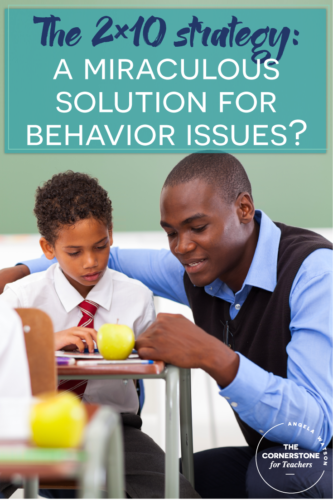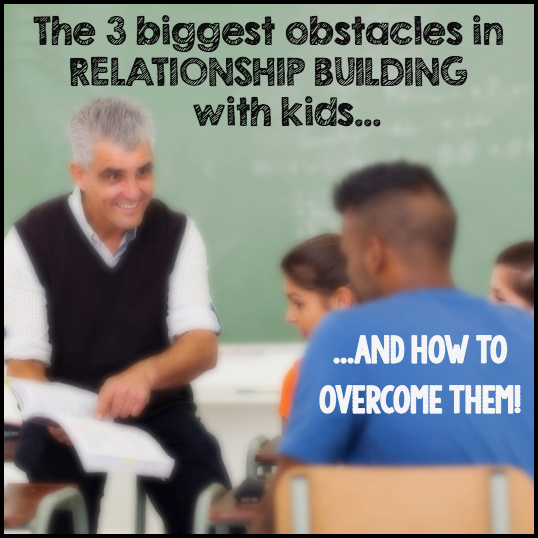I’ve been blogging since 2003, and I don’t think I’ve ever used the term “miraculous” in relation to behavior management (or anything in education, for that matter).
But this is a technique that might be as close as it gets. If you have a student for whom no other solutions seem to work, read on.
The 2×10 strategy is simple: spend 2 minutes per day for 10 days in a row talking with an at-risk student about anything she or he wants to talk about.
There’s no mystery to the reasoning here, of course–the strategy builds a rapport and relationship between teacher and student, and lets the child see that you genuinely care about him or her as a person.
The miracle is in how it turns that abstract, overwhelming, where-do-I-start concept of relationship building into something easily manageable with an immediate payoff for everyone involved.
And the miracle is in how well it seems to be working in real classrooms, at all grade levels, across the country.
I heard about this strategy through a teacher in a Facebook group. A group member who wishes to remain anonymous shared this story:
One of my kindergarten girls has been pretty disruptive. During rest time today, I called her over to just talk and we spent more than the two minutes. I learned that her dad has been in jail lately. I learned she loves tarantulas and spiders. I learned she likes it when her mom lets her practice writing her name. Of course then I let her write her name using sticky notes and highlighters and she positively loved it. I learned she thinks her handwriting looks bad so I encouraged her that she will get better with practice. She wanted to know how to spell my name then said, “How do you spell ‘you are beautiful’?” I let her take the sticky notes with her name and put them in her backpack. She danced to her backpack and wanted to keep one of the notes stuck on her shirt. She came back over and said she wanted to stay and learn more. Silly girl, I am the one who was learning!
This experience touched my heart today. I am confident that this small investment of time and others in the future will yield major changes in this little girl’s classroom behavior. It is not easy to find the time. I had high priority things I could/should have been working on but I wouldn’t trade today’s experience for anything.
An update from the same teacher a few days later:
Her behavior was different — better — today! She had a gleam in her eyes. I am a believer now. The way I teach has changed forever.
Of course, other group members read this and wanted to try it out. Here’s another story:
I am not sure who posted the other day about 2×10, where you just chat with a student for 2 minutes for 10 days, but THANK YOU! I tried it yesterday and today with one of my first grade boys, who has already been written up twice for hitting since the beginning of the school year. For the rest of the day and today he was much for attentive in class. Today he chose to read right next to my table during read-to-self.
I also tried it today with a girl who is repeating first grade, is on meds for ADHD, and possibly will be diagnosed with ODD. Since the beginning of the year, she has needed constant reminders to stay on task. After the chat, she needed very few reminders to stay on task. Yes, I had assessing paperwork I could have been doing instead of talking, but I learned so much more from my 2 minute chat with my students. Thank you again, for reminding me what teaching is all about … making connections and building relationships.

So where did this strategy originate? Some people say it’s just what good teachers do. But I did some digging around online and found an article from ASCD based on the research of Raymond Wlodkowski. He reported “an 85-percent improvement in that one student’s behavior. In addition, he found that the behavior of all the other students in the class improved.” I was especially impressed by this anecdote:
Martha Allen, an adjunct professor at Dominican University’s Teacher Credential Program in San Rafael, California, asked her student teachers to use the Two-by-Ten Strategy with their toughest student. The results? Almost everyone reported a marked improvement in the behavior and attitude of their one targeted student, and often of the whole class. Many teachers using the Two-by-Ten Strategy for the first time have had a similar corroborating experience: Their worst student became an ally in the class when they forged a strong personal connection with that student.
Pretty impressive, right? I absolutely LOVE the idea of the 2×10 strategy. Considering how much time many of us spend addressing classroom disruptions and disciplining students, a 2 minute a day investment seems like a no-brainer.
Additionally, I love that this strategy helps teachers focus on the good in their most challenging students so we can avoid falling into the trap of viewing a disruptive kid as a problem instead of a person. It’s much easier to muster up the enthusiasm and patience you need for working with challenging kids if you have genuine empathy for them and get to spend time enjoying their company rather than always correcting them.
Bottom line: As much as teachers would like to have one-on-one convos with every student every day about anything the student wants to talk about…time restraints make that hard. The 2 x 10 is an easy structure to make sure it gets prioritized.
If you try this strategy out with one of your students, will you report back and let us know in the comment section how it went? I’d love to hear about your experiences.
UPDATE OCTOBER 12th: Thank you all for the tremendous response to this post. I’m happy to hear so many of you are already doing this, and I’ve written a follow-up post to address questions about the 2×10 strategy. I’ve shared advice on what to do if:
- the student doesn’t want to talk to you
- you don’t have time for individual conversations
- you don’t know how to get the conversation started
- you’re unsure of what to ask students
- students give you one-word answers
I’ve also specifically addressed middle and high school teachers. I’m looking forward to continuing the conversations!

Angela Watson
Founder and Writer
Sign up to get new Truth for Teachers articles in your inbox
Discussion
OR

Join our
community
of educators
If you are a teacher who is interested in contributing to the Truth for Teachers website, please click here for more information.

















I work with at risk high schoolers i n an alternative school and always spent time talking to the tougher kids and often have less trouble with them than some of my peers. I am looking forward to consciously trying this strategy in the upcoming year, as I just pre viewed my class lists and there are quite a few names in there that are gonna take some work to get through to.
I love this idea! Come to think of it, last year several students did it themselves – they excused themselves from classes and instead of going to the boys’ room came to me – just for a couple of minutes, just to talk a bit. And the teachers said they noticed some improvement in their attitude!
This works with adults also, in nursing homes! People who turn anger on others are hurting on the inside and can no longer hold it in. We need to be compassionate and find out why they are hurting. Too many times we are in a rush and just want to fix the immediate problem and not look for root cause. It’s easy to assign blame or a diagnosis, it’s harder to invest yourself in another person’s world.
This is so, so well said. Thank you.
I teach in an ED school. Developing relationships with your students is a must. However, most ED students cannot have a normal relationship. Everyday is different. Some days they are happy and able to cope. Other days they are cursing you out and their misery is all your fault. This the norm…it does not usually change. There is a big difference between ED & BD. The majority of students in a typical classroom are BD. If you have a student that does not respond to intervention please have them re-evaluated by the school psychologist. ED students have real disabilities and developing a relationship with them will not cure them.
Linda, thanks for drawing attention to the fact that some students do need to evaluated or re-evaluated, and that the results of relationship-building can be inconsistent with students who have socio-emotional issues (and all students, actually.) I think the important thing is to not give up, and to keep doing whatever it takes to support your students and show them you care.
I’m not a teacher but I AM a grandmother to 4 little ones in the same family who are very close in age. Visiting them (out of state) often includes being dog-piled and hugged by all four at once–a challenge at my age! Last time I visited (2 months ago) I took each one individually on a different day to go out and do something they enjoy–just a brief one on one. One wanted to go and catch polliwogs and then get an ice cream cone! One wanted to get ice cream and then go to a special store. One wanted to be read to and snuggled all by herself. Those moments were so special to all of us and I immediately noticed the difference for the rest of my visit. They willingly gave each other room to talk without interrupting as much, and they took turns better when we played games!